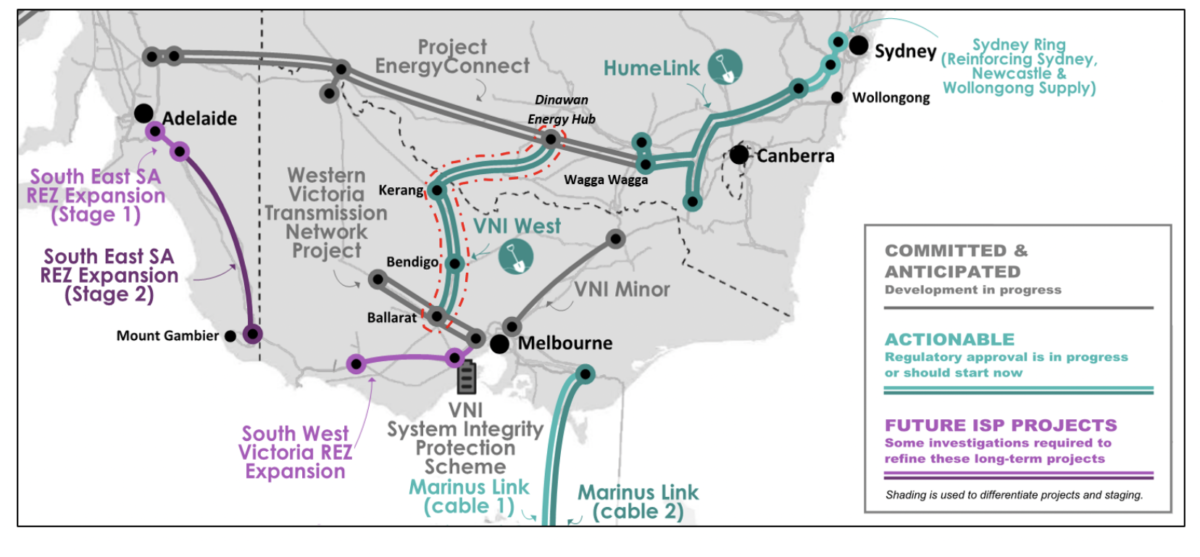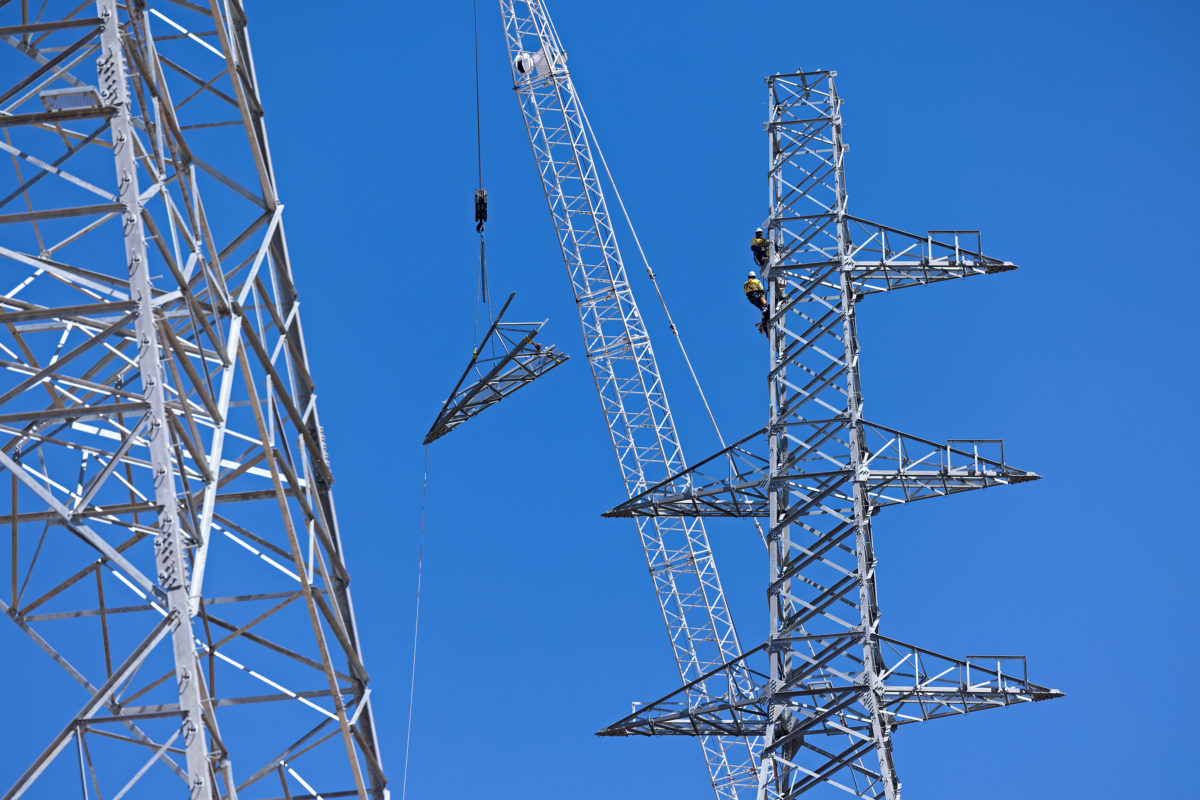Simon Bartlett, former Powerlink COO, University of Queensland Professor and member of the National Electricity Market’s Reliability Panel, has coauthored a scathing consultation submission to the Australia Energy Market Operator (AEMO), alongside Professor Bruce Mountain, Director of the Victoria Energy Policy Centre at Victoria University.
The pair claim one of AEMO’s cornerstone transmission projects, the Western Renewables Link and VNI West (WRL-VNI), will triple transmission charges in Victoria, make the states susceptible to natural disaster blackouts, and will ultimately increase grid congestion.
“Our critique has examined the situation in Victoria, but we would expect the same conclusions apply in respect of the NSW part of WRL-VNI,” Bartlett and Mountain write in the foreword, addressed to AEMO CEO Daniel Westerman.

Image: Transgrid
The proposed Western Renewables Link and VNI West project entails a 500 kV interconnector running from the outskirts of Melbourne, through Western Victoria and into New South Wales. If developed, the project will be the biggest single expense in the Victorian transmission system in more than 50 years, Bartlett and Mountain claim.
The project is also an integral part of AEMO’s energy masterplan, known as its Integrated System Plan or ISP. Bartlett and Mountain acknowledge this rather uncomfortable fact, noting the wide ramifications of their critique.
“After this long [submission] process, we are left with no option but to conclude… that AVP [AEMO Victorian Planner] has delivered a [project] recommendation that relies on biased, flawed and in parts dishonest analysis. We appreciate the seriousness of these allegations but our duty to our professions leaves us with no option but to make them.”
VNI West planning process
The submission stands in stark contrast to what proponents and governments have been claiming about the interconnector, which is usually hailed as the key to unlocking 1.8 GW of renewable capacity between Australia’s two most populace states.
The regulatory assessment stage for VNI West interconnector closes in early 2023, with the authors noting the Victorian Government used its legislative powers to make the Consultation Report, to which this submission responds, the last step in the regulatory approval process.
In February, AEMO was cleared to start early works on the VNI West project and its Environment Effects Statement is expected a year earlier than originally anticipated. The VNI West is aiming for completion by 2028.
Critique
The project’s acceleration appears rather troubling in light of Bartlett and Mountain’s critique, with the pair accusing the AVP, the Victorian planning division of AEMO, of “badly under-estimating” the project costs, particularly of the option it prefers.
While the pair do not have access to AEMO’s own modelling, they estimate the project would double transmission charges in Victoria and lay the foundation for further transmission developments that together will triple transmission charges in Victoria.
“WRL-VNI will also detrimentally affect the efficiency of the Victorian power system by wasting existing transmission capacity (the extensive 500 kV and 220 kV network from the Latrobe Valley to Melbourne) and forcing the development of renewable electricity in locations that are further away from Victoria’s main load centre and will have a large part of their renewable energy wasted by spillage due to severe congestion on VNI West. This too will push prices up relative to what they otherwise would be,” the submission claims.
The pair also take aim at the overall design concept of the interconnector, which they say relies on a “single, heavily-loaded 500 kV transmission line for most of its proposed 500 kV backbone stretching 3,300 km from Tasmania to Townsville.”
This design makes it prone to being impacted by natural disasters, the authors claim – noting that according to AEMO’s own modelling, bushfire risk to transmission lines will increase almost 10-fold between now and 2050 as the climate changes. Such an occurrence would leave Victoria with blackouts and “extensive electricity rationing” until the damage is rectified, the authors say.
Finally, Mountain alleges the project concept relies on a 13 year old blueprint that has “long since been superseded.”
“AEMO is stuck in the past, pursuing a redundant vision that suits its corporate interests,” Mountain says. “Under the guise of providing solutions for the urgent energy transition, AEMO has pushed for an unchecked monopoly. Energy ministers have, so far, caved-in to its demands.”
This content is protected by copyright and may not be reused. If you want to cooperate with us and would like to reuse some of our content, please contact: editors@pv-magazine.com.









Well what do these two propose then? Or are they just canning someone else’s work? One thing the Trump era has taught us is that when someone is accusing another party of corruption that it has been the party making the accusation who was engaged in the corruption. Not the other way around.
I’m happy to be proven wrong here if that claim of theirs is supported by any evidence. On the other hand, I feel it would not be a surprise if in their case, we find connections to gas and fuel sponsors.
As the journalist, you might want to consider that or potentially look into it. If what they ‘claim’ is true, the people need to know. But, if we find their wages are supported by one of the subsidised coal or gas companies, we need to know that also. As do you.
With respect to their natural disaster claim, I have trouble seeing how this is possible considering the land that is allowed and must be cleared, and kept clear around HV lines. At least the proposed system will allow for at least one of the two main connectors to go down between states as opposed to the current system of only having one main line that when it goes down, as it did in the huge storm in SA over 10 years ago, the entire state doesn’t get shut down..
Once again, within their formal submission, did it have their recommendation? If they see flaws like incorrect estimates (even though, as you indicated in your article, they don’t have access to AEMO modeling)
Hi Paul,
No, Bruce Mountain and Simon Bartlett are not secret fossil fuel lobby mouthpieces. They are not arguing against Australia’s decarbonisation nor questioning its build out of renewables. Rather, their argument is the current form of this particular transmission project is highly problematic. They make a number of suggestions in their detailed 118-page submission, which is available to read here: https://www.vepc.org.au/_files/ugd/92a2aa_18d15bdcf9034cc68684754e0c14d526.pdf
With Australia’s renewables industry today mature, and soon to be dominant, there will likely be a lot more critiques of renewable energy plans which are credible and not made in bad faith (ie. by fossil fuel lobbies). Like any industry, renewable energy is made up of different players with different interests and goals, some of which will be flawed.